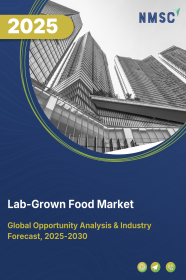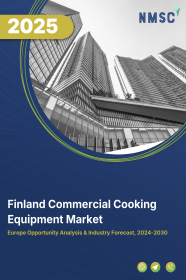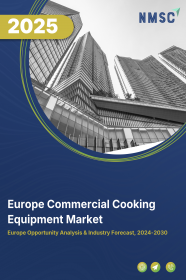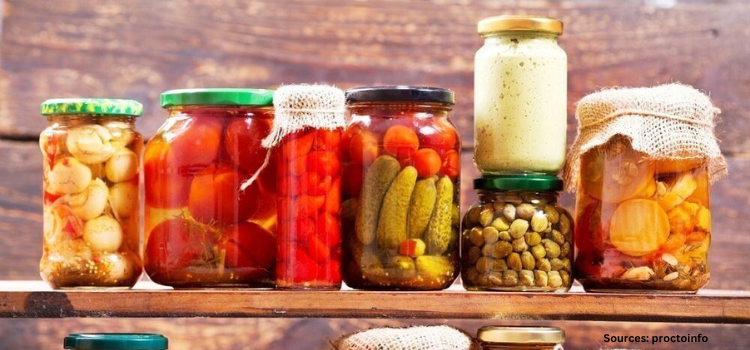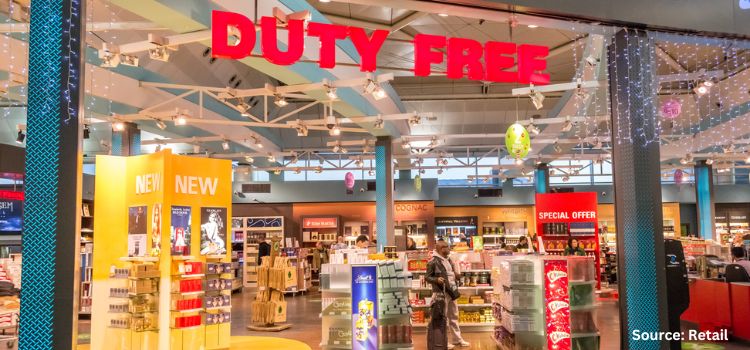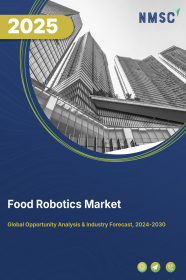
Food Robotics Market by type (Articulated Robots, Delta & Parallel Robots, Collaborative Robots, Cartesian Robots, SCARA Robots, Cylindrical Robots, Portal Robots and Other Types), by Payload (High, Medium, and Low), by Application (Palletizing & Depalletizing, Packaging and Repacking, Pick-and-Place, Cutting and Slicing, Grading and Sorting, Butchery, Quality Inspection, and Other Applications) – Global Opportunity Analysis and Industry Forecast 2022-2030
US Tariff Impact on Food Robotics Market
Trump Tariffs Are Reshaping Global Business
Market Definition:
The Food Robotics Market size was valued at USD 2.24 billion in 2021 and is predicted to reach USD 5.36 billion by 2030 with a CAGR of 9.7% from 2022-2030.
Food robotics refers to the machines used in the food & beverage industry to perform various complex activities such as dispensing, picking, sorting raw-material, packing, labeling packages, and palletizing. They help perform repetitive and tedious production tasks at high speed. Also, they save space and time, lower production costs, improves the cleanliness, safety, and efficiency in the manufacturing facilities. Moreover, these robots are equipped with intelligent vision systems that allow them to specify placement of products and sort them by color, size and shape with incredible accuracy.
Market Dynamics and Trends:
The demand for food robotics is rising due to the enactments of stringent food safety regulations around the world. Also factors such as growing adoption of digitalization in the food and beverage industry, increasing focus on efficient food packaging, and rising labor costs are expected to propel the growth of the market. Moreover, emergence of low-cost robots with greater functionality are factors expected to boosts the market growth.
However, high cost of installation, and lack of skilled workforce required to operate and maintain the robots are expected to restrain the growth of the market to some extent. On the other hand, adoption of social distancing measures due to the Covid-19 pandemic and surging demand for packaged food products are expected to create lucrative growth opportunities for the food robotics market players in future.
Market Segmentations and Scope of the Study:
The food robotics market has been segmented based on type, payload, application, industry verticals, and geography. Based on type, the market is bifurcated into articulated robots, delta & parallel robots, collaborative robots, cartesian robots, SCARA robots, cylindrical robots, portal robots and other types. The articulated robot’s segment is further classified into selective compliance articulated robot arms, six-axis robots, and other articulated robots. Based on payload, the market is divided into high, medium, and low. Based on application, the market is divided into palletizing & depalletizing, packaging and repacking, pick-and-place, cutting and slicing, grading, and sorting, butchery, quality inspection, and other applications. Based on industry verticals, the market is divided into dairy, beverage, meat, poultry, seafood, bakery & confectionary, fruits & vegetables, oil & fats, and other industries. Geographic breakdown and analysis of each of the aforesaid segments includes regions comprising of North America, Europe, Asia-Pacific, and RoW.
Geographical Analysis:
Asia Pacific region holds the lion share of food robotics market and is expected to continue dominating the market during the forecast period. This is attributed to factors such as growing awareness regarding food hygiene, stringent government regulations, and growing competition in the FMCG sector. Also, reduction in the operating costs and labor cost is anticipated to boost the demand for robotics in the food industry, which will ultimately benefit the food robotics market growth in this region.
However, North America is expected to show a steady rise in the food robotics market due to higher production capacities and the growing number of manufacturers. Also, rising disposable income among the millennial population is creating demand for processed and packed food, which in turn boosts the market growth in this region.
Competitive Landscape:
The market comprises of various players such as Harpak-ULMA, Fanuc Corporation, KUKA AG, Rockwell Automation Incorporated, Asic Robotics AG, Mistubishi Electric Industries, Denso Corporation, Fuji Robotics, Kawasaki Heavy Industries, Ltd, and ABB Group. These manufacturers are actively indulging in R&D initiatives, product & technology innovations, and industrial collaborations to enhance their product and increase their growth and geographical reach.
For instance, in September 2021, Harpak-ULMA announced their partnership with FANUC America to improve automation, robotics, and software solutions. The aim of this partnership was to showcase that how advanced technology CXE, can provide greater value and transform the food packing sector. Also, in January 2020, FANUC announced their partnership with Soft Robotics. With this partnership, FANUC can access to soft robotics ‘Factory of the Future’ technology and soft robotics can take advantage of FANUCs global customers. FANUC will implement the Soft Robotics technology into their portfolio including Soft Robotics’ mGrip.
Key Benefits
-
The food robotics market report provides the quantitative analysis of the current market and estimations through 2022-2030 that assists in identifying the prevailing market opportunities to capitalize on.
-
The study comprises a deep dive analysis of the food robotics market trend including the current and future trends for depicting the prevalent investment pockets in the market.
-
The information related to key drivers, restraints and opportunities and their impact on the food robotics market is provided in the report.
-
The competitive analysis of the market players along with their market share in the food robotics market.
-
The SWOT analysis and Porters Five Forces model is elaborated in the study.
-
Value chain analysis in the market study provides a clear picture of the stakeholders’ roles.
Key Market Segments:
By Type
-
Articulated Robots
-
Selective Compliance Articulated Robot Arms
-
Six-Axis Robots
-
Other Articulated Robots
-
-
Delta & Parallel Robots
-
Collaborative Robots
-
Cartesian Robots
-
SCARA Robots
-
Cylindrical Robots
-
Portal Robots
-
Other Types
By Payload
-
High
-
Medium
-
Low
By Application
-
Palletizing & Depalletizing
-
Packaging and Repacking
-
Pick-and-Place
-
Cutting and Slicing
-
Grading and Sorting
-
Butchery
-
Quality Inspection
-
Other Applications
By Industry Verticals
-
Dairy
-
Beverage
-
Meat
-
Poultry
-
Seafood
-
Bakery & Confectionary
-
Fruits & Vegetables
-
Oil & Fats
-
Other Industries
By Geography
-
North America
-
U.S
-
Canada
-
Mexico
-
-
Europe
-
UK
-
Germany
-
France
-
Spain
-
Italy
-
Netherlands
-
Rest of Europe
-
-
Asia-Pacific
-
China
-
Japan
-
India
-
Australia
-
South Korea
-
Taiwan
-
Vietnam
-
Rest of Asia-Pacific
-
-
RoW
-
Latin America
-
Middle East
-
Africa
-
Key Players
-
Harpak-ULMA
-
Fanuc Corporation
-
KUKA AG
-
Rockwell Automation Incorporated
-
Asic Robotics AG
-
Mitsubishi Electric Industries
-
Denso Corporation
-
Fuji Robotics
-
Kawasaki Heavy Industries Ltd.
-
ABB Group
REPORT SCOPE AND SEGMENTATION:
|
Parameters |
Details |
|
Analysis Period |
2021–2030 |
|
Base Year Considered |
2021 |
|
Forecast Period |
2022–2030 |
|
Market Size Estimation |
Billion (USD) |
|
Market Segmentation |
By Type (Articulated Robots, Delta & Parallel Robots, Collaborative Robots, Cartesian Robots, SCARA Robots, Cylindrical Robots, Portal Robots and Other Types), by Payload (High, Medium, and Low), by Application (Palletizing & Depalletizing, Packaging and Repacking, Pick-and-Place, Cutting and Slicing, Grading and Sorting, Butchery, Quality Inspection, and Other Applications), By Industry Verticals (Dairy, Beverage, Meat, Poultry, Seafood, Bakery & Confectionary, Fruits & Vegetables, Oil & Fats, and Other Industries) |
|
Geographical Segmentation |
North America (U.S., Canada, Mexico) Europe (UK, Germany, France, Spain, Italy, Netherlands, Rest of Europe), Asia-Pacific (China, Japan, India, Australia, South Korea, Taiwan, Vietnam, Rest of Asia-Pacific), Rest of the World (Latin America, Middle East, Africa) |
|
Companies Profiled |
Harpak-ULMA, Fanuc Corporation, KUKA AG, Rockwell Automation Incorporated, Asic Robotics AG, Mistubishi Electric Industries, Denso Corporation, Fuji Robotics, Kawasaki Heavy Industries, Ltd, and ABB Group. |

















 Speak to Our Analyst
Speak to Our Analyst



